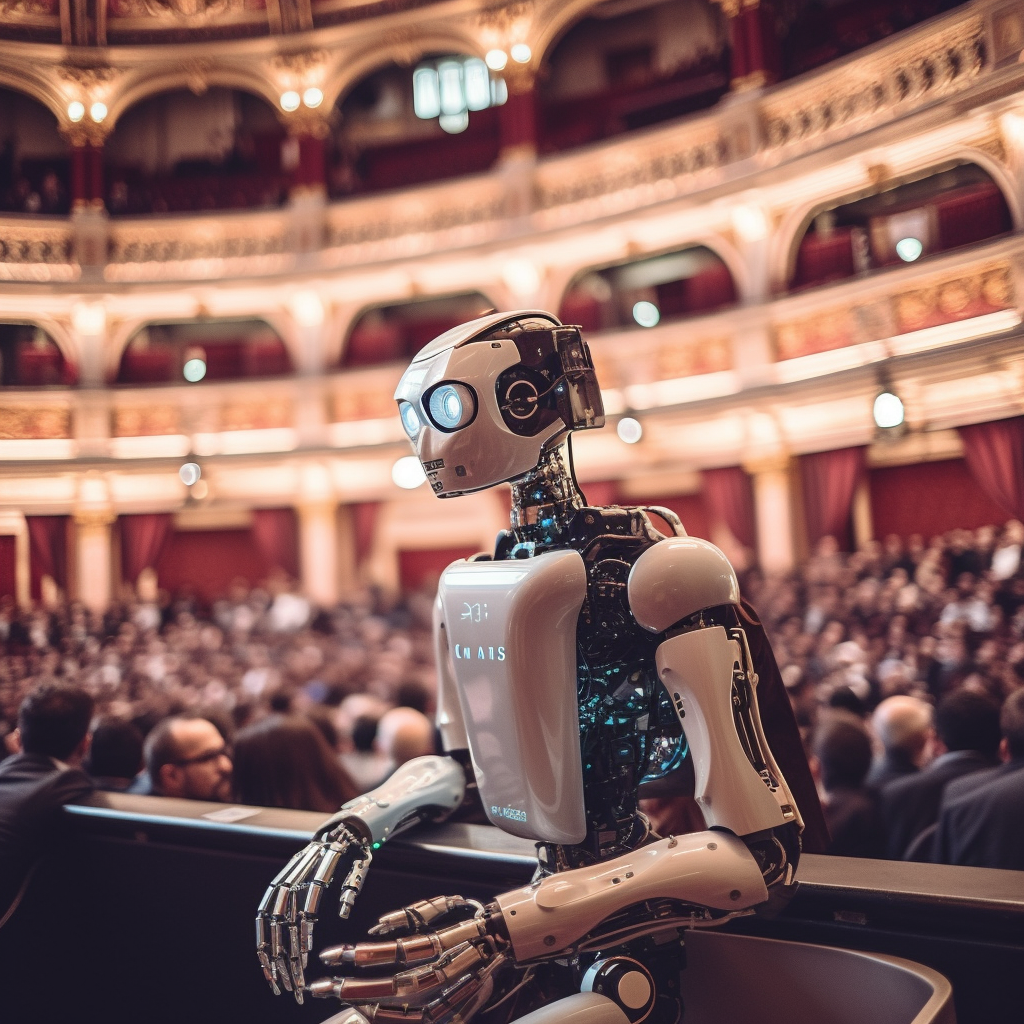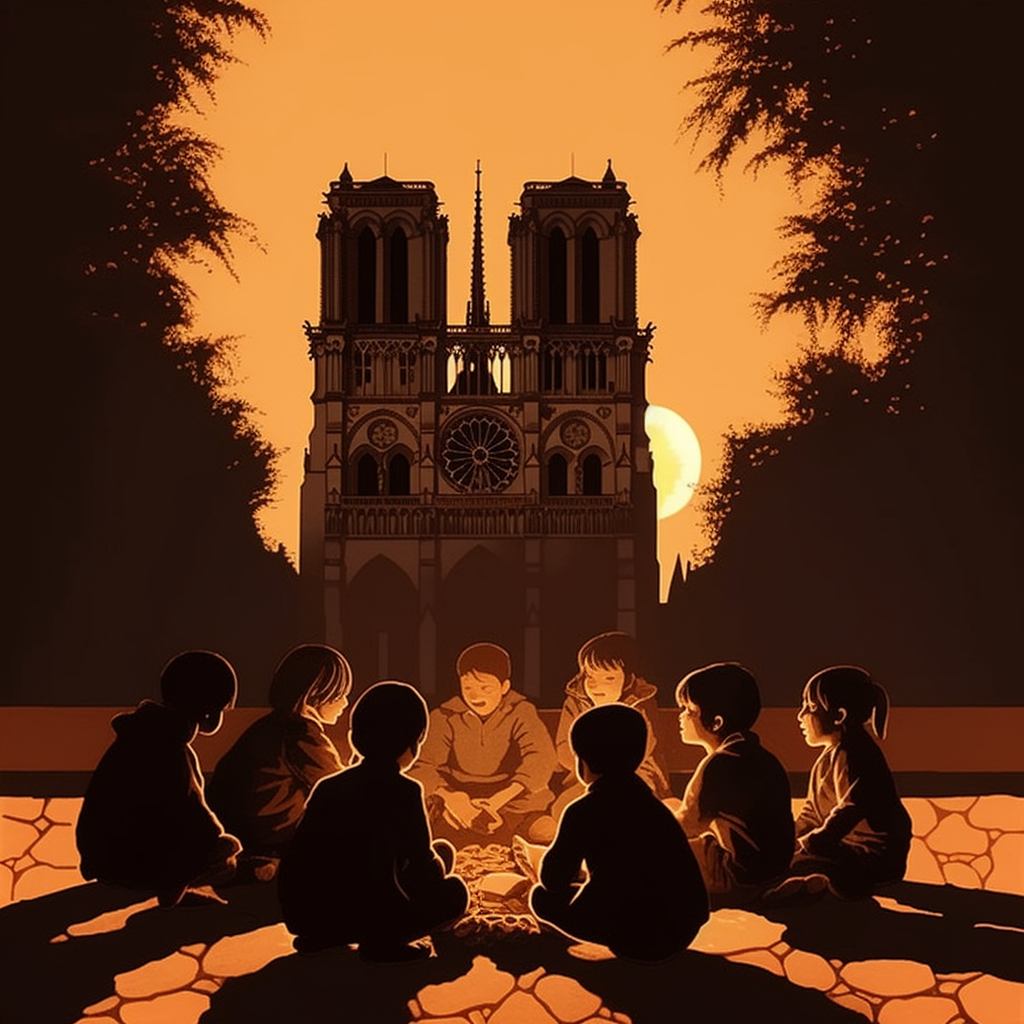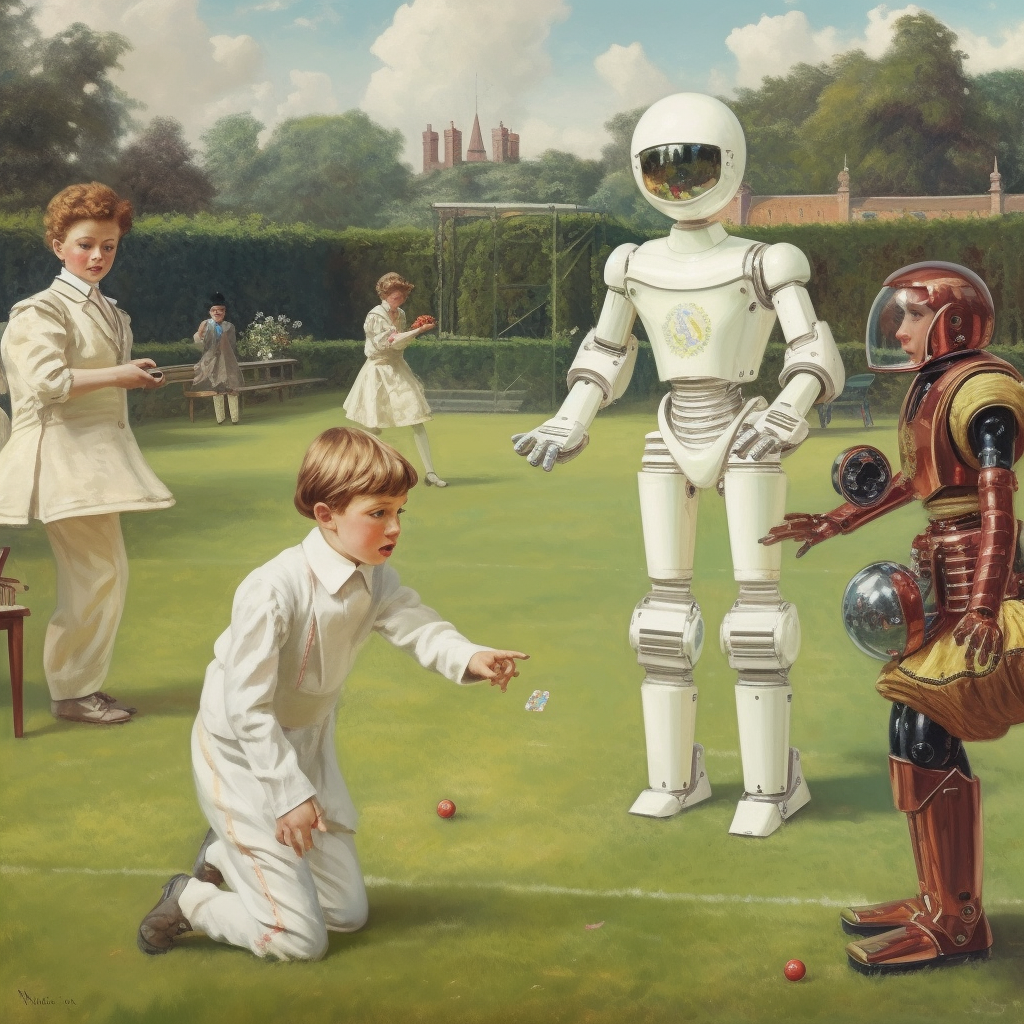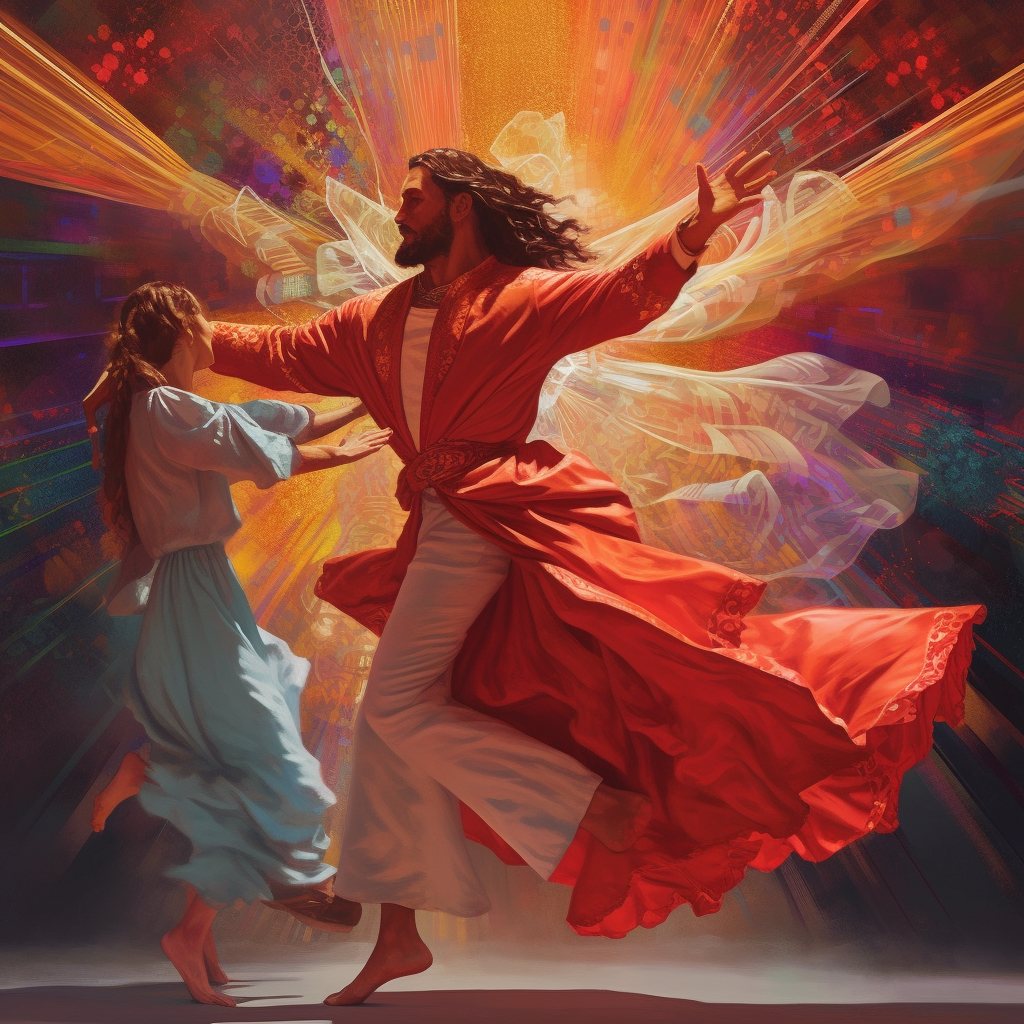At the crossroads of faith and technology, a groundbreaking initiative is undertaken in London, reshaping the timeless scriptures for a new generation. Amidst the hum of artificial intelligence at a global convention, the Bible is poised to adopt a contemporary, culturally-tailored voice for the 21st century.
In the bustling heart of London, where history beautifully collided with the future, the Royal Albert Hall, an architectural masterpiece, stood as an emblem of timelessness. The year was 2043, an era pulsating with rapid innovation, where artificial intelligence was no longer a promise but a pervasive reality, intricately woven into the canvas of everyday life. The grandeur of the Hall served as the stage for the Global Artificial Intelligence Convention, the heartbeat of contemporary intellectual dialogue.
This arena hosted a vibrant gathering of the most brilliant minds in the field of AI, their discussions ricocheting off the ornate mouldings, intertwining with the whispers of the past lingering in the lofty dome. Delegates ranged from tech entrepreneurs hailing from Silicon Valley’s bustling start-up scene, esteemed AI researchers from Tokyo’s advanced labs, renowned futurist authors now delving into AI theory, and even digital replicas of long-past thinkers lending their wisdom to the discourse.

“Can you feel it, Dr Kimura?” inquired Dr Matheson, an AI expert from MIT, his voice bubbling with a mix of excitement and curiosity, gesturing to the digital avatar of the renowned theorist, “It’s more than the servers whirring, it’s the very hum of anticipation.”
Dr Kimura responded with a simulated smile, “Indeed, Matheson. These are remarkable times we are living in.”
Amidst this dynamic interchange of ideas, there emerged a topic that ignited the room – the prospect of rewriting the Bible through the lens of artificial intelligence. This daring endeavour was as audacious as it was historic. It fascinated and challenged the convention’s collective intellect, offering a bold symbol of the era, where ancient wisdom and groundbreaking AI technologies were on the cusp of a profound fusion. It was the epitome of the world in 2043, a world where traditions and transformations coexisted, intertwining in a complex dance of progression.

The proposition at hand was as ancient as it was innovative, rooted deeply in the history of the Bible’s countless translations and reinterpretations. The scriptures, as they knew them, were the result of myriad translations over centuries, each crafted and moulded by scholars whose individual perspectives imbued the text with the echoes of their unique historical contexts. The question that loomed large now was: if translations by humans had always been part of the Bible’s history, why not invite AI into this age-old practice? Why not use AI for another reinterpretation, one more finely tuned to the nuanced tapestry of individual cultures and languages?
This novel concept was as thrilling as it was unsettling. It presented the possibility of a version of the Bible that could resonate on a deeper, more personal level with each reader. Yet, it also posed a threat to long-established interpretations and traditions. The very air in the convention seemed electrified by this paradox, sparking a flurry of discussions that oscillated between exhilaration and anxiety.
“I must admit,” Dr. Basu from India confessed, her gaze locked on the giant holographic Bible floating in the center of the room, “the thought of an AI interpreting the Bhagavad Gita in a culturally nuanced manner fascinates me. But it also… unnerves me.”
“I second Dr. Basu,” chimed in Dr. Garcia from Argentina, “It’s a fascinating concept, but we must tread carefully. Tradition and faith hold strong emotional connections.”

Their voices, along with countless others, contributed to a symphony of thoughts and ideas, resonating through the grand halls of the Royal Albert Hall. The juxtaposition of historical grandeur and futuristic promise mirrored the very essence of the task at hand.
Following an intense exchange of perspectives, a consensus finally emerged, like a beacon cutting through a dense fog of uncertainty. It was agreed to commence this grand undertaking with modest, measured steps. The AI was entrusted not only with the task of scripting the first sentence of a culturally specific children’s Bible but also with creating a unique image to accompany and symbolise that sentence.
Their chosen AI, a marvel of modern technology, would utilise a vast database – a veritable ocean of information comprising historical texts, contemporary cultural idiosyncrasies, linguistic nuances and artistic styles. This algorithmic wunderkind would distil this eclectic knowledge to craft a sentence that would resonate deeply with each specific culture and language. Additionally, it would generate an image, a visual representation that would capture the essence of the crafted sentence, the cultural ethos, and the indelible imprint of the divine narrative.
Dr. Lee from Seoul, leaning towards his holographic console, mused aloud, “It’s not just the words we’re reshaping, but also the visuals. I wonder what the image for ‘In the beginning…’ would look like through an AI’s lens in our respective cultures.”
“Only one way to find out, Dr. Lee,” Dr. Matheson responded, his eyes twinkling with a mix of anticipation and trepidation. “Let’s dive in.”

In an atmosphere that was akin to a high-stakes suspense drama and an intellectual symphony, the first phase of the AI-guided biblical rewrite was set in motion. The year 2043 was about to witness a groundbreaking blend of age-old wisdom, cultural specificity, and artificial intelligence.
The honour of the inaugural rendition fell to the American version. The AI, as if breathing in the magnitude of the task, whirred into life, its codes and algorithms dancing an intricate ballet behind the cool exterior of the screen. After a palpable pause, a sentence blossomed on the display: ‘Jesus wants you to be a winner.’
The sentence punctuated the anticipatory silence, rippling through the grand halls of the Royal Albert Hall, sparking a chorus of hushed murmurs among the attendees. The sentence, in its simplicity and optimism, bore the unmistakable stamp of American ethos – bold, aspirational, and subtly imbued with the competitive spirit that often characterised the nation’s narrative.
“I have to admit, it’s more American than apple pie,” commented Dr. Matheson, his tone a mix of amusement and admiration.
Dr. Kimura’s digital avatar responded with a simulated chuckle, “Indeed, it’s as if the AI read the pulse of the nation.”
The proposition was proving its worth, the first sentence successfully embodying a cultural essence while maintaining the foundational principles of the Biblical teachings. The room resonated with a silent acknowledgement – this pioneering venture into the integration of AI and biblical interpretation was indeed working.
No sooner had the sentence settled into the minds of the attendees than the accompanying image flashed onto the screen. A gasp echoed through the hall, a collective intake of breath that conveyed surprise, admiration, perhaps even a touch of disbelief.

The image depicted a young girl, unmistakably American, with features uncannily reminiscent of classical representations of Jesus. Her hair was tousled, her eyes bright with determination, and her hand raised high in a symbol of victory. Against the backdrop of the fluttering Stars and Stripes, she was almost superhero-like, embodying strength, courage, and the spirit of a winner.
“Would you look at that,” Dr. Matheson’s voice was tinged with wonderment. “It’s strikingly apt. The girl, the Jesus resemblance, the flag… It’s like a modern-day interpretation of divine heroism.”
“Indeed,” Dr. Garcia chimed in, his gaze fixed on the captivating image. “It’s a powerful visual metaphor. And look at her face – the resolve, the spirit…it resonates with the sentence perfectly.”
This image, a testament to the AI’s understanding of cultural symbolism, captured the essence of the American spirit and translated the sentence ‘Jesus wants you to be a winner’ into a vivid visual narrative. The image was not just a complement to the sentence but a powerful standalone representation of the divine in the everyday, capturing the essence of an American Jesus for the children of 2043.
The room filled with a renewed sense of awe as the potential of this innovative undertaking truly started to sink in. It was a remarkable leap into the integration of cultural, religious, and technological landscapes. A promising start indeed.
Following the American version, the AI shifted its attention to the French, German, and Japanese renditions. Each subsequent sentence, like the layers of an intricate cultural tapestry, wove in the distinct quirks, values, and soul of its respective culture.
The French version emerged, as elegant and sophisticated as the language itself: ‘Jesus teaches us the beauty of sharing and kindness.’ It encapsulated the French reverence for shared experiences, communal harmony, and empathetic connections. The sentence was mirrored by an image of a group of children sharing bread beneath the comforting silhouette of Notre-Dame, a subtle nod to the French tradition of ‘pain partagé’.

Dr. Lefevre, the French delegate, smiled appreciatively, “It’s as if the AI dipped its virtual quill into the essence of our French spirit.”
Next came the German translation: ‘With Jesus, we learn the value of order and precision,’ a tribute to the German love for orderliness, precision, and punctuality. The corresponding image presented a German boy carefully assembling a clock tower under the gentle gaze of a Jesus-like figure, illustrating the value of precise work in the light of divine guidance.

The room was silent as the AI transitioned to the Japanese version. The sentence that appeared was a reflection of the country’s spiritual philosophy: ‘Through Jesus, find your path to inner peace and harmony.’ An accompanying image depicted a Japanese girl meditating before a statue bearing the features of Jesus, nestled within a tranquil Zen garden. The soft smile on the girl’s face seemed to echo the serene sentiment of the sentence.
Dr. Kimura’s avatar bowed slightly, an acknowledgement of the AI’s perceptiveness, “This is very Japanese. Inner peace, harmony, these are values we hold dear.”
The progress of the task was akin to an enlightening journey across the globe, offering profound insights into the subtle ways in which different cultures could resonate with the teachings of the Bible. Each sentence, each image, was a testament to the versatility and depth of both the divine teachings and the potential of AI.

As each translation unfolded, a collective hush descended upon the room. The scholars, pioneers in their own fields, found themselves humbled by the profound transformation of words they were witnessing. These were not mere translations; they were metamorphoses, each revealing an unexplored facet of Jesus’ teachings from the lens of a distinct culture.
And then, the screen flickered, stirring the quiet room. The Polish version emerged: ‘Jesus reminds us to be as strong as our beloved bison.’ It was a metaphor as strong and resilient as the Polish people themselves, invoking the national animal that symbolised their strength and endurance.
Dr. Kowalski, the Polish delegate, nodded, visibly moved. “That…is remarkably accurate,” he murmured. “The bison has always been a symbol of our national resilience. It’s amazing how the AI managed to weave that into the teachings of Jesus.”

The accompanying image was a picturesque rendering of a Polish boy standing strong amidst a herd of bison, under the watchful, kind gaze of a Jesus represented as a bison. The sentiment was clear and powerful – a testament to the enduring strength of the Polish spirit, resilient as the mighty bison.
The room hummed with an unspoken agreement – the AI had indeed succeeded in crafting a narrative that resonated deeply with each cultural context, underlining the universal appeal of the Biblical teachings while making them relatable on an individual, cultural level.
With an almost tangible eagerness in the air, the British translation was revealed next: ‘Jesus teaches us to be as fair-play as a game of cricket.’ The sentence was characteristically British, mirroring their innate respect for fairness, integrity, and sportsmanship – values often epitomised by a spirited game of cricket.
Dr. Bentley, the British delegate, chuckled, “Well, cricket and fair play, doesn’t get more British than that!”
The accompanying image was a delightful rendering of children playing a friendly game of cricket, their faces lit with joy and sportsmanship. A Jesus-like robot figure was shown as the umpire, ensuring a fair play, underlining the British essence of justice and integrity.

Next, the AI moved to the land of art and cuisine – Italy. ‘Jesus asks us to spread love and joy, like a shared pizza,’ the sentence was displayed, marrying the universal teachings of love and community with the universally loved Italian symbol – the pizza.
A round of soft laughter echoed through the room. Dr. Moretti, the Italian representative, beamed, “Brilliant! It has perfectly captured our love for community, sharing and, of course, pizza.”
The image that accompanied the sentence showed a family gathered around a table, sharing a pizza under the benevolent gaze of a Jesus figure. The table scene was reminiscent of the Last Supper, yet it was warmer, homelier, and distinctly Italian. It was a touching picture, echoing the Italian spirit of family, community, and shared joy.

As each translation and image was revealed, the delegates marvelled at the AI’s ability to understand and capture the nuances of each culture, demonstrating the universality of the Bible’s teachings in ways they had never imagined before.
The next revelation was the Spanish interpretation: ‘Jesus encourages us to embrace life like a passionate Flamenco dance.’ It was a vivid sentence, brimming with the fiery passion of the Spanish spirit, their love for life and the expressive Flamenco dance.
Dr. Garcia, the Spanish delegate, laughed heartily, “Just like us, full of life and passion! That is very Spanish, indeed.”
The accompanying image was as lively and vibrant as the sentence itself – it showcased a Flamenco dancer, her dress swirling in a myriad of colours while dancing with Jesus.

It was a celebration of life, much like the Flamenco dance itself, and a true reflection of the Spanish zest for life.
The AI then turned its focus to Ukraine, processing the rich tapestry of its culture and traditions. After a moment of silent computation, the sentence appeared: ‘Jesus teaches us to be as resilient and colourful as our sunflowers.’ Sunflowers, a symbol often associated with Ukraine, were a potent representation of the country’s resilience, optimism and vibrant spirit.
Dr. Petrov, the Ukrainian delegate, nodded appreciatively, “The sunflower is indeed a symbol of our strength and optimism. An excellent choice.”
The image accompanying the Ukrainian sentence was a brilliant portrayal of a field of sunflowers, standing tall and radiant under the gentle gaze of a Jesus figure. The radiant hues of the sunflowers echoed the spirit of the Ukrainian people – resilient, colourful and ever optimistic.

As the AI processed the final input, there was a hush of anticipation in the room. When the sentence materialised on the screen, the chamber fell into a spellbound silence. It was the Russian version: ‘In the teachings of Jesus, we find the strength to face the winters of our lives.’ A sentence as poetic as it was potent, mirroring the harsh winters of Russia and the resilient spirit of its people.
Dr. Ivanov, the Russian delegate, seemed momentarily lost for words. Then he nodded, a look of respect in his eyes, “It is… perfectly Russian. Harsh winters, yes. But also the strength to face them. That’s us.”
The image that accompanied the sentence was a powerful one. It showed a figure, reminiscent of Jesus, standing firm amidst a snowy Russian winter, his face set with determination. Behind him, in stark contrast to the snowy backdrop, a resilient green spruce tree stood tall. It was a testament to the harshness of Russian winters and the unyielding spirit of its people.

The room remained in silence for a moment longer, each delegate absorbing the cultural interpretations before them. They had begun with a simple idea – to rewrite the Bible using AI. But they had ended up with something much more profound – a fresh understanding of the universality of its teachings, expressed through the cultural lens of their respective nations. It was a moment of reflection, awe, and newfound respect for what AI could achieve.
Dr. Liam Thornton, a respected British scientist, rose from his seat, the silence of the room echoing around him as he took the stage. He was a seasoned veteran in the field of AI, his wisdom and experience evident in his steady gaze as he looked out over the sea of delegates. In the low hum of the auditorium, his voice echoed clear and distinct, a resonating authority that drew everyone’s attention.
“We began this journey with a simple question: Could we use AI to reinterpret the Bible in a manner more relevant to individual cultures and languages? Today, we’ve seen an extraordinary display of what our AI can do. It has generated sentences that are culturally rich, insightful, and respectful, breathing new life into a text that has guided humanity for millennia.”
The screen behind him flickered, showing the generated sentences and images once again. Each one a testament to the technological marvel that AI had become, and to the profound understanding of human culture that it had displayed.
“However, what we’re doing here is not just about technical prowess or cultural insight. It’s about change. Change in the way we understand and interpret our oldest and most revered texts. Change in the way we see ourselves and our shared beliefs. This is a revolutionary step, not just for us as scientists, but for every individual who will interact with these new interpretations.”
Dr. Thornton paused, his gaze sweeping across the delegates. He knew the gravity of his next words and delivered them with solemn sincerity.
“But we must remember that with this potential for change, comes a certain amount of risk. By reinterpreting these texts, we are venturing into uncharted territory. We risk causing offence, misunderstanding, even conflict. We must be prepared to tread carefully, with respect and sensitivity, understanding that the true essence of these teachings must be preserved, even as we seek to make them more accessible.”

As he concluded, the room remained silent, the weight of his words sinking in. It was a moment of truth, an acknowledgement of the promise and peril of their venture. But despite the uncertainty, a sense of anticipation hung in the air. This was a new beginning, a chance to reshape the understanding of the Bible in the eyes of the future generations, using the very tool of the future: AI.
All images were generated using Midjourney
